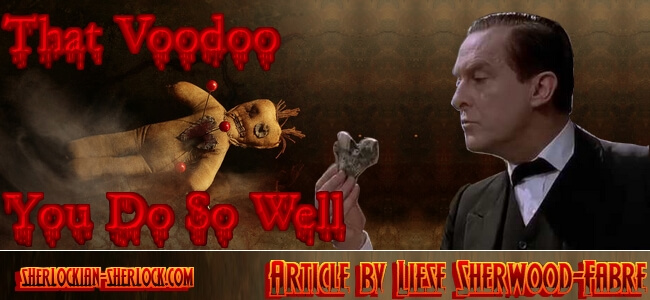That Voodoo You Do So Well


Author: Liese Sherwood-Fabre, award-winning writer

In “The Adventure of Wisteria Lodge,” Sherlock, Watson, and Inspector Baynes found some rather odd items in a house’s kitchen: a human figure with a shell belt, a dead white cock, a pail of blood, and charred bones. Based on these findings, Baynes arrested Garcia’s cook for his employer’s murder to lure the actual perpetrator from hiding. Holmes explained the cook’s objects were related to an animal sacrifice made to appease the gods before attempting an important activity. While Holmes indicated he had researched the practice at the British Museum, the description had little to do with true voodoo rituals and more about misinformation commonly reported in the 1800s.
The origins of vodou—the currently preferred spelling—are traced back to Haiti, (1) although it incorporates much of vodun, a West African religion practiced by about 30 million people. (2) In addition to a supreme being, Bondye, other spirits (lwa or loa) have dominion over various parts of life, and depending on the worshiper’s needs, offerings are made to the spirit controlling that aspect—such as a farmer would focus on the spirit of agriculture, or one desiring love to another spirit. When those from West Africa were brought to Haiti, Brazil, Cuba, and Louisiana as slaves, they incorporated aspects of this religion into Roman Catholicism when their owners “converted” them. Over time, many of the spirits became associated with Christian saints. (3)
Offerings to these spirits can include animal sacrifice, a practice appearing in many religions including Islam and Hinduism. When such sacrifices are made in vodou, the animal is then cooked and shared among members, primarily the poor. (4) Current practices are moving away from such sacrifices although they may still occur in more rural areas. A high priestess in New Orleans, a vegan, has reported no problem completing her rituals without such traditions. (5)
Similarly, the use of fetishes has been misrepresented. Talismans used for medicine or spiritual power can be found in West African markets and may include statues or dolls representing gods and dried animal parts. (6) The elaborately crafted images provide a personal connection to the spirits and have no purpose related to harming or controlling another person. (7)
Perhaps the most misunderstood aspect of vodou religion is spiritual possession. While some religions view such practice as evil, vodou practitioners seek such an experience. The belief is that a soul can leave a body during possession, with a spirit replacing it and creating a sort of religious frenzy. Such control is different from zombies who lack their soul and can be controlled by bokors by magical means and have no resemblance to the human-eating monsters in current films. (8)
The origin of such distorted views of vodou practices can be traced back to Victorian publications providing second-hand accounts of such activities. While the actual events have been obscured by time, a trial in Haiti in 1864 condemned eight men and women to death for the murder and cannibalism of a young girl. European papers carried the story, and Sir Spenser St. John repeated the trial’s particulars in his commentary of his time as the British Consul-General in Haiti. (9) Another Briton, James Froude, reported incidents of serpent worship and animal and child sacrifice a priest shared with him in 1888. (10) William Newell, however, suggested these accounts were “myths,” comparing the description—and even the name—to practices of a European sect in the fifteenth century. (11)
While Holmes recognized the items the cook left in the kitchen as part of a vodou ritual, he depended on Eckermann’s treatise to provide the meaning and practice behind them, repeating the misconceptions prevalent in Victorian England and perpetuated today in Hollywood. The facts regarding the cook’s activities cleared him of any involvement in the murder, just as understanding vodou’s true beliefs and customs would strip the practice of its maligned mystique.

Resources:
1) https://www.livescience.com/40803-voodoo-facts.html
2) https://www.npr.org/templates/story/story.php?storyId=1666721
3) https://www.livescience.com/40803-voodoo-facts.html
4) https://slate.com/culture/2013/11/anthony-karen-a-photographers-look-inside-a-haitian-voodoo-ritual-photos.html
5) https://www.vice.com/en/article/gvmnwb/the-vegan-vodou-high-priestess-of-new-orleans-isnt-interested-in-animal-sacrifice
6) https://www.npr.org/templates/story/story.php?storyId=1666721
7) https://macaulay.cuny.edu/seminars/lutton07/articles/v/o/d/Vodou.html
8) https://www.livescience.com/40803-voodoo-facts.html
9) https://www.smithsonianmag.com/history/the-trial-that-gave-vodou-a-bad-name-83801276/
10) James Anthony Froude, The English in the West Indies, London: Longmans, Green, and Co. 1888, page 303.
11) William Newell, “Myths of Voodoo Worship and Child Sacrifice in Hayti,” The Journal of American Folklore, Vol. 1, No. 1, 1888, pages 16-30.
Thank you very much for this article Liese Sherwood-Fabre.

Recommended articles:

Read more:
Articles by Liese Sherwood-Fabre


|












